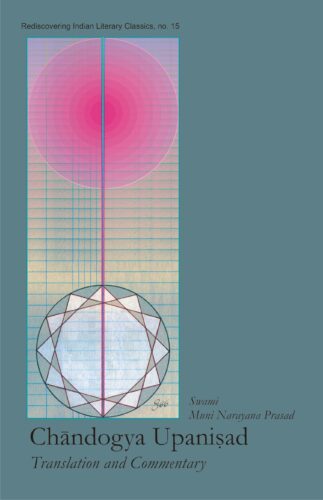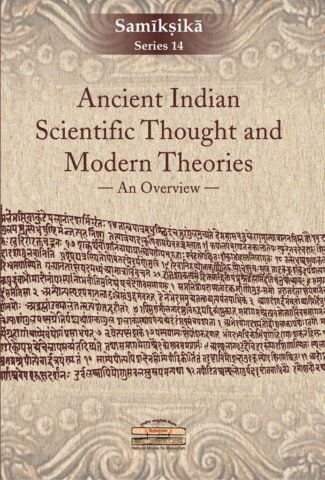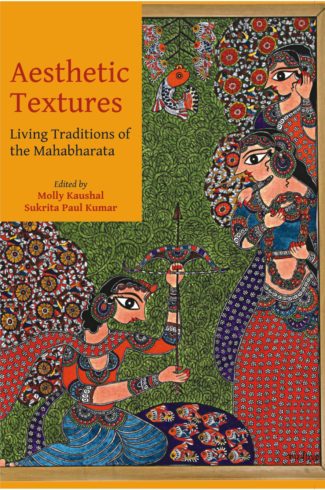-


Sanskrit Drama...
Sanskrit Drama
With Special Reference to Prahasana and Vithi by: S. RamaratnamThe book is an attempt to present the Vithi and the Vithyangas in Sanskrit covering all aspects of theory and practice. Based on an in-depth study of source material the work examines several theories of rasa realization besides presenting a detailed treatment of hasya rasa.
₹1,170.00
ISBN: 9788124606551
Year Of Publication: 2014
Edition: 1st
Pages : xiii, 498p.
Bibliographic Details : Appendices ; Bibliography; Index (Sanskrit and English)
Language : English
Binding : Hardcover
Publisher: D.K. Printworld Pvt. Ltd.
Size: 23
Weight: 900
Prahasana and the Vithi are two of the major playforms in Sanskrit Drama. Though studies on some individual prahasanas and vithis have appeared from time to time in research journals, there is no comprehensive study of the two playforms on comparative basis, undertaken so far. The present book is an attempt to cover all aspects of prahasana and vithi, in theory and practice. It is based on an in-depth study of manuscripts, microfilms and transcripts collected from various sources.
Beginning with the important aspects of Sanskrit drama, the book briefly examines the theories of rasa realization and presents a detailed account of the hasya rasa besides undertaking a study of the theoretical aspects of the prahasana first and the vithi in a later chapter, as sanctioned in the works on dramaturgy. It also presents an account of the suddha prahasanas that provide a contrasting picture in comparison with the samkirna variety. The work also analyses a few important vithi specimens. The chapter on the Vithyangas is a special feature of the work. Illustrations from well-known dramas serve to explain the textual matter with a rare clarity of thought and expressions.
This volume will interest scholars and students of Indology who are focused on the study of Sanskrit drama and dramaturgy, in particular, and literature, in general. It will also benefit readers interested in ancient Indian theatre.
Foreword Satyavrat Shastri
Preface
Views of Scholars
Abbreviations
1. Sanskrit Dramaturgy
Introduction
Origin of Sanskrit Drama
Types of Sanskrit Drama
Nataka Prakarna Bhana Prahasana Dima Vyayoga Samavakara Vithi Anka Ihamrga
2. Theory of Rasa : Hasya Rasa
The Rasa
Hasya Rasa
Six Kinds of Laughter
Is Hasya a Secondary Rasa?
Position of Hasya among the Rasas
The Definition of Hasya: A Re-appraisal
The Divinity and Colour Symbolising Hasya
A Brief Survey of Hasya in Sanskrit Literature
3. Theory and Practice of Sanskrit Prahasanas
Origin and Development
Characteristics of the Prahasana
Abhinavaguptas Views on Prahasana
The Prahasana Elements
The Vithyangas
Prahasana Elements and the Vithyangas in Other Forms of Literature
The Relation between the Prahasana and Other Rupakas
Characters Appearing in the Prahasanas
Paradoxical Names of Characters
Hero and Heroine in the Prahasana
Vulgarity in the Prahasanas
Prakrit in Prahasanas
Rasas Other than Hasya in the Prahasanas
Number of Acts in the Prahasanas
Lasyangas in Prahasanas
Natyadharmi and Lokadharmi
Theatrical Aspects
Instrumentation
Nandi and the Prologue
The Bharatavakya
Stage Worthiness
4. The Suddha Type of Prahasanas
Introduction
The Bhagavadajjukiya
Authorship of the Bhagavadajjukiya Bodhayana Kavi Date of the Bhagavadajjukiya The Play Character Study Literary Merits in the Play The Sentiment Hasya Prahasana Elements in the Bhagavadajjukiya Rasas Other than Hasya in the Bhagavadajjukiya Alamkaras Metres Philosophical Ideas Present in Bhagavadajjukiya Style of the Bhagavadajjukiya Dramatic Technique The Influence of Sruti and Smrti Texts Influence of Bhagavadajjukiya on Other Prahas Prakrt in Bhagavadajjukiya The Commentary Social Conditions of the State at the Time of Bhagavadajjukiya Conclusion
The Mattavilasaprahasana
Author and Date The Plot Character Study Literary Merits Alamkaras Hasya in Mattavilasa Prahasana Elements and Vithyangas Dramatic Technique The Prakrt in Mattavilasa Mattavilasa on Stage Episodes, Allusions and other References Mattavilasa and Other Rupakas State of Society as Represented in Mattavilasa
Hasya Cudamani Prahasana
The Plot Character Study Literary Merits of the Play Hasya in the Hasyacudamani Prahasana Elements and Vithyangas in Ha.Cu. Dramatic Technique Merits of the playwright The Influence of BA on Ha.Cu. The Influence of Ha.Cu. on Later Prahasanas Prakrt in the Ha.Cu. State of Society as Depicted in the Ha.Cu.
The Madanaketucarita
The Author The Plot of the Madanaketucarita Character Study Literary Merits of the Play Hasya in Madanaketucarita Prahasana Elements and Vithyangas in the Play Rasas Other than Hasya in the Play Alamkaras Metres Prakrt in MKC Dramatic Technique in MKC
Epilogue The Influence of the Bhagavadajjukãya on MKC
5. The Samkirna Type of Prahasanas
The Well-Known Prahasanas
The Latakamelaka The Natavata Prahasana The Dhurtasamagama Prahasana The Hasyarnava Prahasana
The Minor Prahasanas
The Damaka Prahasana The Gauridigambara Prahasana The Kuhanabhaiksava The Somavalliyogananda The Kautuka-ratnakara The Kautuka Sarvasva The Dhurtanartaka Prahasana The Prahasanas of Harijivanamisra Adbhutataranga Palandumandana Vibudhamohana The Sahrdayananda The?Ghrtakulyavali Hasya in Harijivanamisras Plays Venkatesvara Kavi and His two Prahasanas The Sandrakutuhala of Krisnadatta The Dhurtavidambana of Amaresvara The Kuksimbharabhaiksava Prahasana The Candauranjana The Mundita Prahasana The Kaleyakutuhala of Bharadvaja The Subhagananda The Vinodaranga The Hasyakautuhala Prahasana The Mithyacara Prahasana The Lokaranjana Prahasana
6. Theory and Practice of the Vithi
Vithi and the Open Air Theatre
Characteristics of the Vithi
The Vrttyangas and the Vithyangas
The Relation between the Vithi and Other Rupakas
Characters Appearing in the Vithi
Rasas in the Vithi
Lasyangas in the Vithi
Theatrical Aspects of the Vithi
Nandi, Prologue and the Bharatavakya
7. The Vithi Specimen
Dutavakya
The Plays of Bhasa The Plot Innovations in the Plot Characters Appearing in the Play The Rasas in the Play The Style of the Dramatist Dramatic Elements in Dutavakya Poetic Merits of the Play Vithyangas in the Play Is Dutavakya a Vithi?
Malatikavithi
Indulekhavithi
Lilavativithi
The Author and His Works The Text of Lilavativithi The Dramatic Plot Character Study Rasas in the Play Dramatic Technique Vithyangas in the Play Descriptive Powers of the Poet Poetic Merits Influence of the Earlier Poets on Ramapanivada Special Features of the Play
Sitakalyanavithi
The Author The Text The Plot The Play Character Study Rasas in the Play Descriptive Powers Poetic Merits Dramatic Technique Sitakalyana as Vithi and Presence of Vithyangas Influence of Other Poets on Venkamatya An Overall Assessment of Sitakalyanavithi
8. The Vithyangas in Sanskrit Drama
Vithyangas in Bhasas Plays
Carudattam Pratijnayaugandharayana Svapnavasavadatta Balacarita Madhyamavyayoga Pancaratra Pratimanataka Avimaraka
The Vithyangas in the Plays of Kalidasa
Malavikagnimitra Vikramorvasiyam Abhijnana-Sakuntalam
Mrcchakatikam (of Sudraka)
Mudraraksasa (of Visakhadatta)
Venisamhara (of Bhattanarayana)
Uttara-Ramacarita (of Bhavabhuti)
Malatimadhava (of Bhavabhuti)
Prabodhacandrodaya (of Sri Krisna Misra)
Karpurmanjari (of Rajasekhara)
Vithyangas in the Prahasanas
9. Conclusion
Appendices
A. List of Non-available Prahasanas & Vithis
B. Modern Sanskrit Prahasanas & Vithis
C. Prahasanas in Other Indian Language
D. The Farce in English Literature
E. Farcical Elements in the Plays of Kalidasa
F. Elements of Farce in the Plays of Harsa
G. Elements of Farce in the Plays of Murari and Jayadeva
Bibliography
Index








